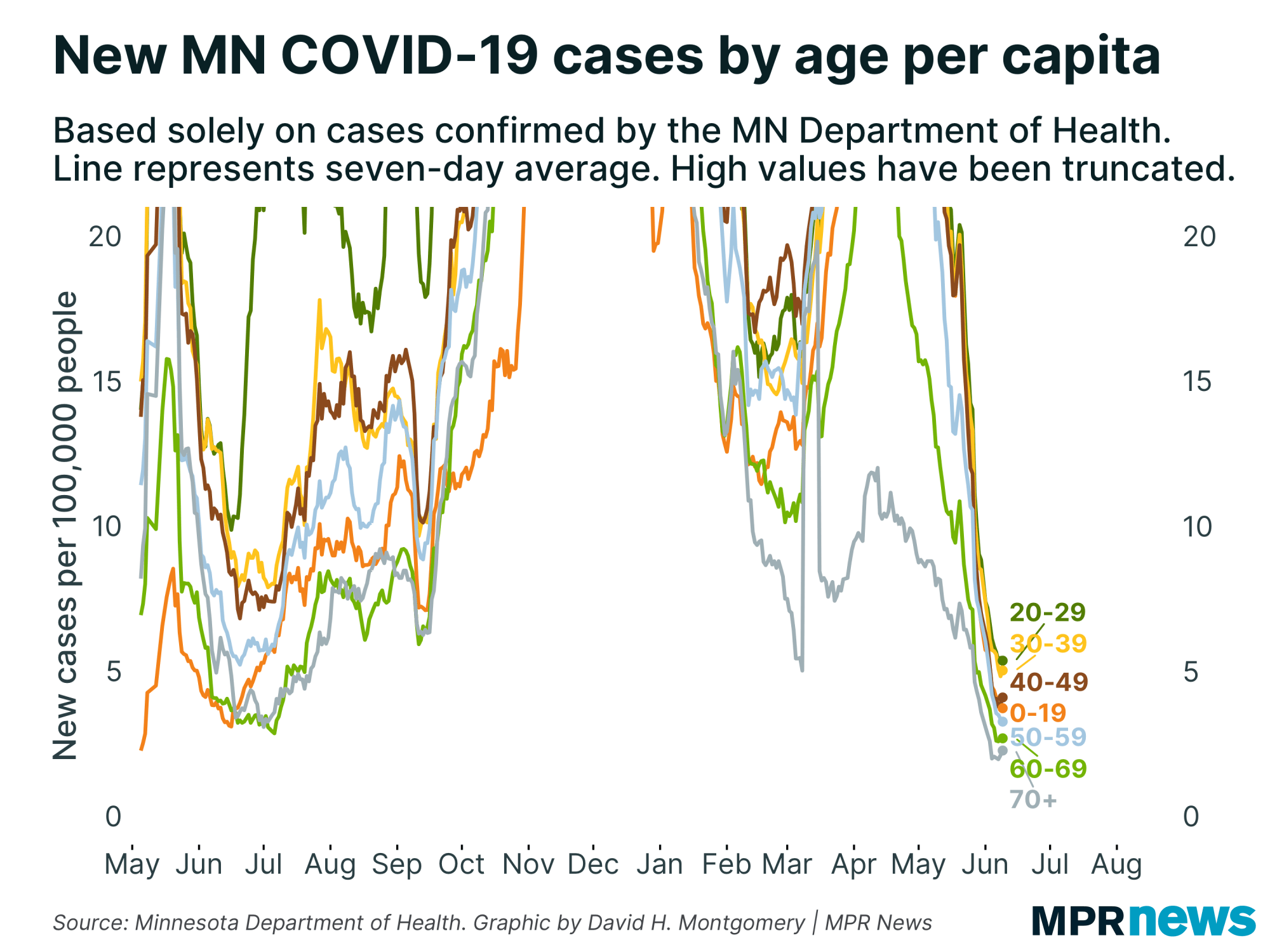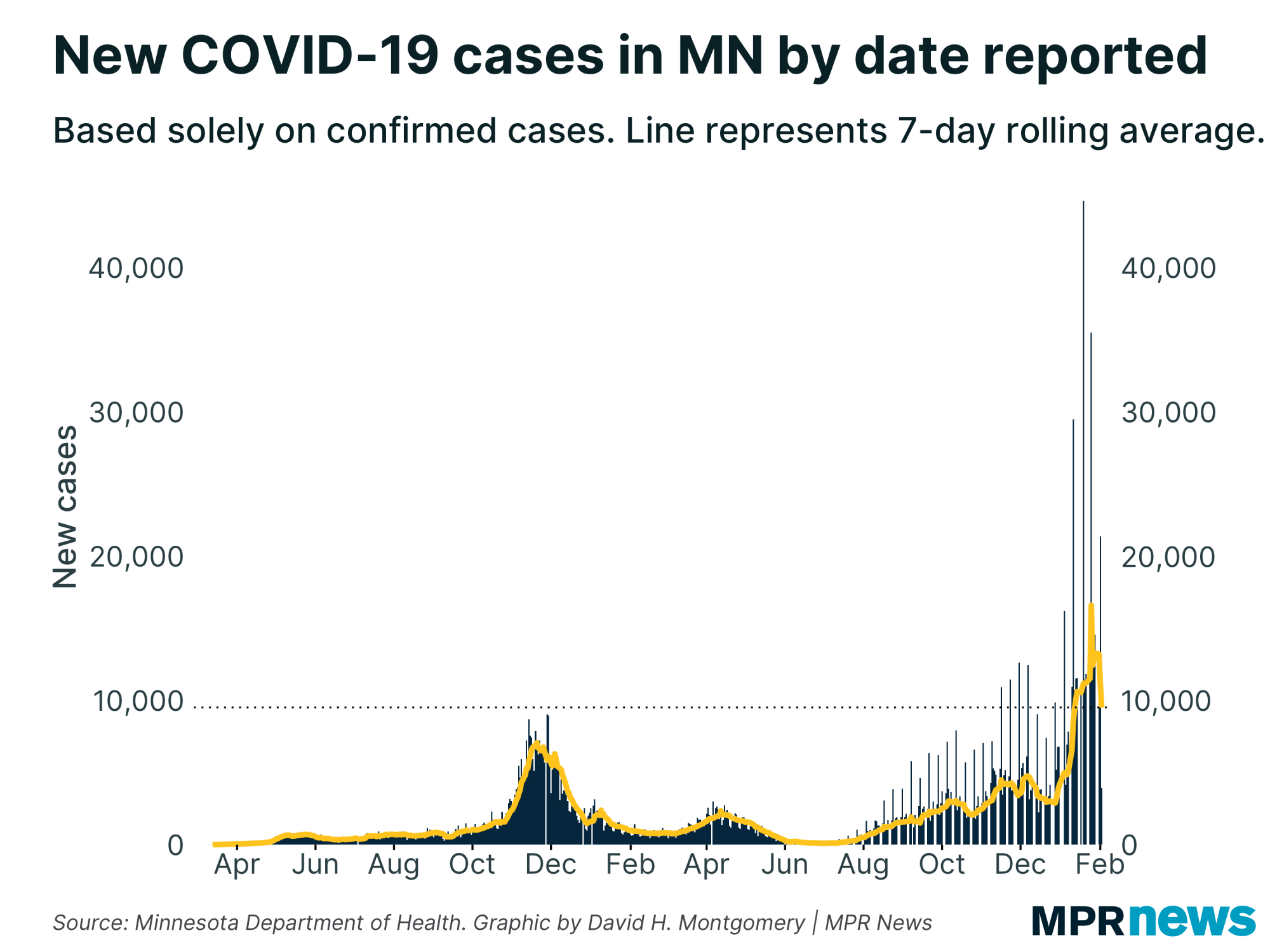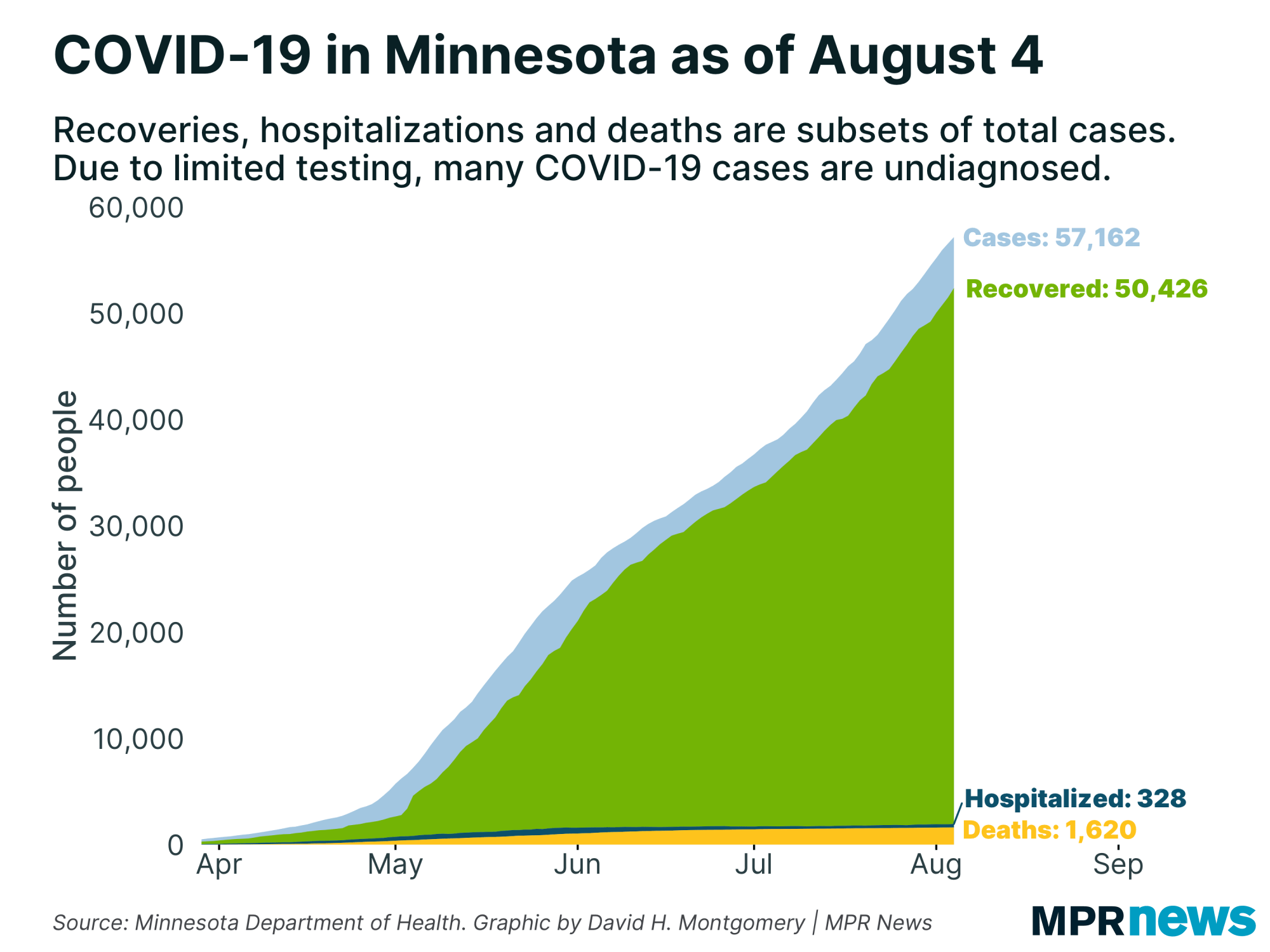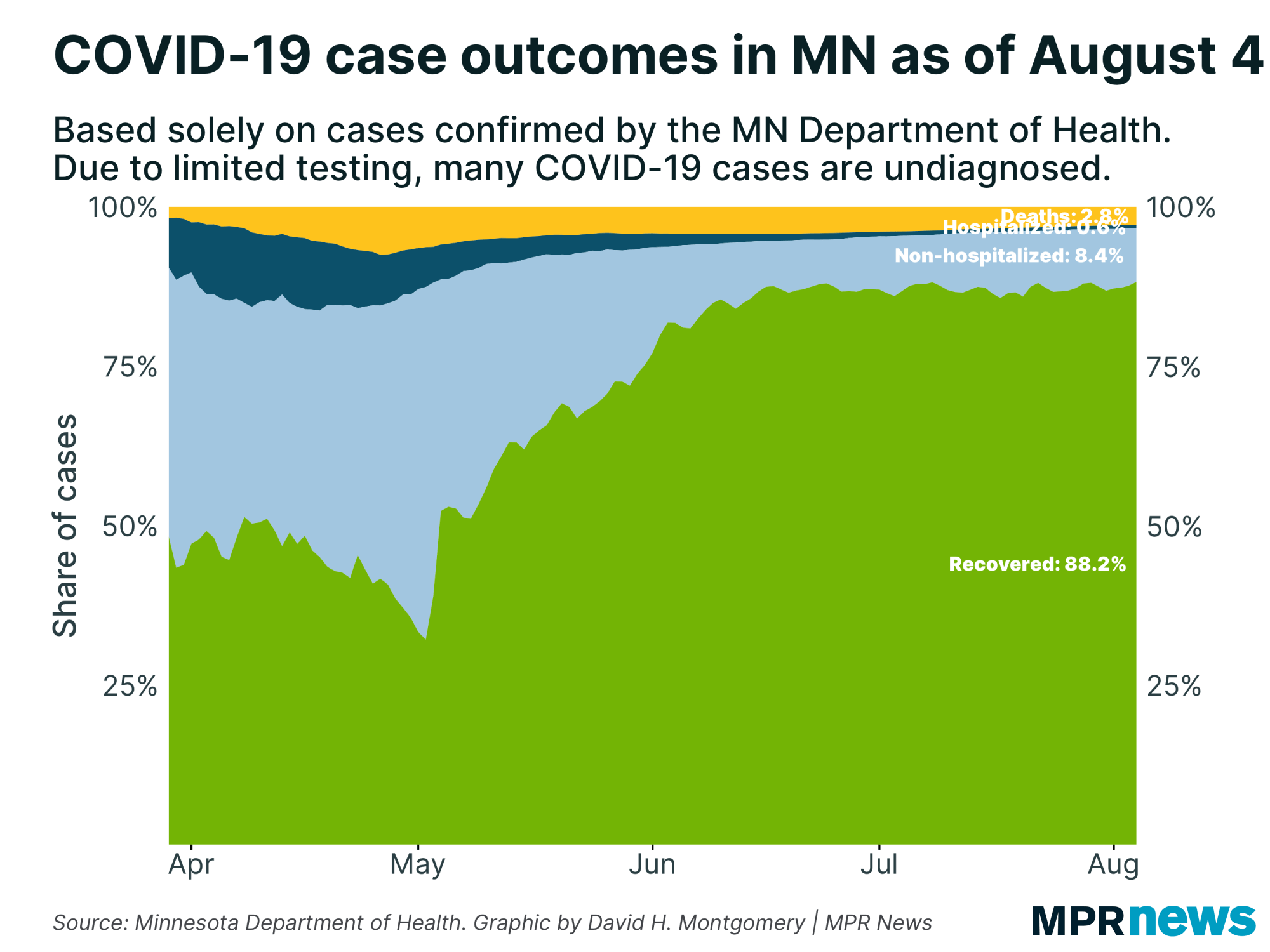July 13 update COVID-19 in MN: As young adult cases jump, spread worries rise

Updated 6 p.m.
With fresh data showing young adults continuing to drive up new COVID-19 case counts, state health leaders on Monday again implored Minnesotans to socially distance and wear masks as they venture back into bars, restaurants and other social spaces.
Officials have been concerned for two weeks about the jump in cases among people in their 20s — now the age group with the most confirmed cases, approaching 10,000 in Minnesota since the outbreak started.

The median age of Minnesotans infected has been trending down in recent weeks and is now below 38 years old.
While the jump in young adult cases wasn’t unexpected as bars and restaurants slowly reopened to indoor customers, the fairly steep rise in cases has been surprising, Health Commissioner Jan Malcolm told reporters.
Create a More Connected Minnesota
MPR News is your trusted resource for the news you need. With your support, MPR News brings accessible, courageous journalism and authentic conversation to everyone - free of paywalls and barriers. Your gift makes a difference.
Officials continue to worry that those newly infected young people may inadvertently spread the disease to grandparents and other potentially vulnerable populations. Malcolm said she expected to see a “second- and third-generation transmission” cascading from those young adult cases in coming weeks.
While current hospitalization counts in Minnesota remain relatively low, “we are likely going to see increases in hospitalizations because of the ripple effect” of younger people becoming infected, said Kris Ehresmann, the state’s infectious disease director.
Young adults, she added, “don’t live in a vacuum.”
Health officials on Monday also warned against calls to accelerate the spread of COVID-19 to build what's known as "herd immunity," saying quickening the pace of transmission could have disastrous consequences.
"That comes at an awfully high cost in terms of an awful lot of illness, a lot of exposure of very vulnerable populations and ultimately a very real potential of over-runing health care capability to provide care to the subset of the people who get very serious disease,” Malcolm said.
She said once available, a vaccine could provide a path to herd immunity in a way that offers protection for the most vulnerable.
Hospitalizations fall, case counts jump
Malcolm’s concerns about young adult spread came hours after her agency reported both positive and worrisome trends in the COVID-19 pandemic. The count of new deaths remains in low single digits, but the number of new confirmed cases continues to leap.
Health Department officials on Monday reported two more deaths, putting the disease’s toll in the state at 1,504.
Daily hospitalizations (247) and people currently needing intensive care (114) continue to dip. Those are two closely watched metrics as officials work to managed the spread of COVID-19 so it doesn’t overwhelm the state’s health care system.
That relatively good news, however, remains tempered by the fact that the number of new daily confirmed cases has risen steeply over the past two weeks, with 499 new cases reported Monday.

Of the state’s 42,772 total confirmed cases since the pandemic began, about 87 percent of those Minnesotans infected have recovered to the point they no longer need to be isolated.
Among those who’ve died, nearly 80 percent were living in long-term care or assisted living facilities.
Besides hospitalizations and intensive care cases, officials are also now closely watching the percentage of people who are testing positive for the disease. The state’s now running a seven-day average of 4.7 percent positive tests, below the 5 percent marker that starts to get officials’ attention, Malcolm said.
Still, she said, there’s “no question that our metrics have gone in a less positive direction in the last couple weeks.”
Walz continues to weigh statewide mask order
Cases have been trending upward in Minnesota for several weeks, in all parts of the state — but especially in the Twin Cities suburbs. Minnesota had nearly 1,500 more active COVID-19 cases than it did in mid-June, according to data released Friday.

Last week, for the first time, the suburban counties of Dakota, Washington, Anoka, Scott and Carver had about as many new cases per capita as Hennepin and Ramsey counties. In mid-June, the five suburban counties were averaging about 70 new cases per day. Over the past week, they averaged 132 new cases per day.
Those numbers and other factors have Gov. Tim Walz considering a statewide order requiring Minnesotans to wear masks in indoor facilities.
Medical groups in Minnesota and the state Health Department continue to support a statewide mask-mandate as the cities Winona, Rochester and Mankato have become the latest cities to make such orders on a local level. Minneapolis, St. Paul and Edina have also mandated mask-wearing in the cities’ public spaces.

On Monday night, the Duluth City Council is scheduled to take up the question of whether to require people to wear face coverings when they're in public spaces.
The proposed ordinance would prohibit businesses or organizations from allowing people over the age of 10 inside their doors without wearing masks.
It includes an exemption for people who are "unable to wear face coverings for genuine medical reasons." And it says people can take off face masks while eating or drinking at a restaurant.
Walz on Monday expressed concern that Minnesotans were lagging in efforts to wear masks to stem the spread. However, Senate Majority Leader Paul Gazelka, R-East Gull Lake, warned a statewide mandate would be a mistake.
Malcolm told reporters that Walz was still considering a statewide mask order and asked for research showing the effect of those policies in other states. “He is really looking at all the data from all the angles,” Malcolm added.
Meatpacking hot spots remain
Many of the outbreaks outside the Twin Cities metro area are focused around meatpacking plants. Officials have intensified testing in those hot spots, uncovering more infections.
That includes Mower County in southeastern Minnesota, where there were 987 confirmed cases as of Monday. Mower County is home to Hormel Foods and Quality Pork Processors. Both have been partnering with Mayo Clinic to ramp up employee testing.
While some of Mower County’s positive cases are associated with people who work in the facilities and with the people they live with, county officials say they are also seeing transmission among people who live in the county but work in other counties where coronavirus is present.
Nobles, in southwestern Minnesota, reported 1,694 confirmed cases as of Monday with six deaths. About 1 in 13 people now have tested positive for COVID-19 in the county since the pandemic began, although the count of new cases has slowed considerably in recent weeks.
Worthington’s massive JBS pork processing plant was the epicenter of the Nobles outbreak. The JBS plant shut on April 20 but has since reopened with expanded hygiene and health monitoring measures.
Similar problems have been reported in Stearns County, where COVID-19 cases tied to two packing plants — Pilgrim’s Pride poultry plant in Cold Spring and Jennie-O Turkey in Melrose — skyrocketed in May. An undisclosed number of workers at both plants have tested positive for the virus.
There were about 55 confirmed cases in Stearns County in early May. By Monday, confirmed cases were at 2,536 with 19 deaths.
Kandiyohi County in west-central Minnesota is also dealing with a significant caseload more than two months after officials with the Jennie-O turkey processing plant there said some employees had tested positive for the coronavirus.
As of Monday, the Health Department reported 595 people have now tested positive in the county. The county had confirmed three COVID-19 cases in late April.
Cases have also climbed noticeably in Lyon County (351 cases), around a turkey processor in Marshall. Cases the past few weeks have also grown in Cottonwood County (142 cases), home to a pork processing plant in Windom in southern Minnesota, but the counts there have since stabilized.
Developments from around the state
Minneapolis moves 50 polling places over virus concerns
Election officials in Minneapolis say they’re relocating 50 polling places, in part to prevent spread of the coronavirus.
About a third of those were in senior high-rises and multi-unit housing, where residents might be particularly vulnerable to the coronavirus. Others were in locations with limited space that wouldn’t allow social distancing.
All told, there will be voting in 94 buildings across the city — some with multiple precincts in the same location. Of those, about a third are in schools, and two dozen in park buildings. Election officials are preparing to institute social distancing protections at those sites.
The city also has already opened an early voting center on East Hennepin Avenue near Interstate 35 West, and is also encouraging voters to apply to vote by mail so they don’t have to come into contact with poll workers or other voters.
Voters will get postcards about their polling locations for both the Aug. 11 state primary and the Nov. 3 general election.
— Tim Nelson | MPR News
Bell Museum, Split Rock Lighthouse reopen this week
The University of Minnesota’s Bell Museum is reopening this week.
The museum closed in March in response to the coronavirus outbreak, but will reopen Thursday through Sunday for members, and next Thursday to the general public.
The natural history museum will have limited hours, Thursdays through Sundays, from 10 a.m to 4 p.m. each day. Masks and reservations are required, and the planetarium isn’t open yet.
On the North Shore, the iconic Split Rock Lighthouse, closed since mid-April, is reopening Wednesday. Timed tickets will be available online, with some available for walk-ups. The interior of the lighthouse and historic Keeper’s House will be off-limits. Tickets have been reduced to $8 to reflect the limited building access.
Other major museums, including the Science Museum, the Children’s Museum and the Minnesota History Center, remain closed amid the pandemic.
— Tim Nelson | MPR News
Top headlines
With mandate possible, here’s what to know about masks: Gov. Tim Walz is likely to decide soon whether to require Minnesotans to wear face masks in public to try to prevent the coronavirus pandemic in the state from getting out of control. Some people can’t stand the masks, which health officials say are critical to curb the spread of COVID-19.
MN Senate GOP tries again to end COVID-19 emergency: Minnesota lawmakers were back in St. Paul Monday for the start of another special session triggered by DFL Gov. Tim Walz wanting to extend a peacetime emergency to address COVID-19. Senate Republicans again tried to end the governor’s emergency powers, but House Democrats back the governor.
COVID-19 in Minnesota
Data in these graphs are based off Minnesota Department of Health cumulative totals released at 11 a.m. daily. You can find more detailed statistics on COVID-19 at the Health Department website.
The coronavirus is transmitted through respiratory droplets, coughs and sneezes, similar to the way the flu can spread.